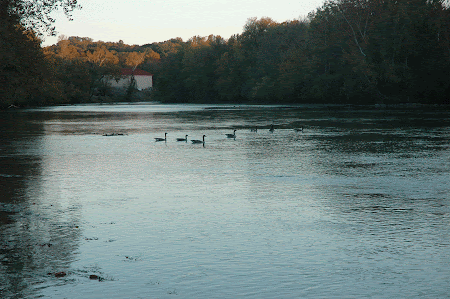The traps of the utricularia gibba (a carnivore) have lost their pigment altogether. You may
recall that I took a picture of a utricularia gibba trap for the 22 Oct
observation (Fig 2.). The plant appears to be degrading. There is quite a bit of debris in the
aquarium this week. Some of the debris are dead protists; while other parts of the debris are the leaf that was placed in the aquarium as food which has broken down (disintegrated). There was a lot less movement in the aquarium
this week. I did capture a video but was
unable to convert it to the proper format for this blog entry. Microscopic life is still teaming within the
aquarium but not to the extent that it was a week ago. The amblestegium varium
still appears green and viable.
Botany-Lab 001-Pyper-Microaquarium Experiment
Sunday, November 17, 2013
Monday, November 11, 2013
Observation of Micro-Aquarium 5 Nov 2013
The aquarium is teaming with microscopic life! There are orange globular spots around the utricularia gibba. I also captured a video of Chaetonotus (Pennak) which is a Gastrotricha as seen in figure 5. The most common life in the aquarium appears to be the Paramecium Aurelia (Rainis, Russell). The teardrop shaped growth in fig 2. of the 22 Oct Blog entry, appears to have died. It has changed color from blue to gray.
Figure 5
Chaetonotus Gastrotricha sp. (Pennak) video taken in the Hesler Biology Building, rm 507.
Tuesday, November 5, 2013
Bibliography
Works Cited
Pennak, Robert W.."Fresh-Water Invertebrates of the United States".1989.John Wiley & Sons, Inc.New York, NY (p. 628)
Rainis, Kenneth G., Russell, Bruce J.."Guide to Microlife".1996.Franklin Watts. New York, NY (p. 287)
Monday, November 4, 2013
Observations of Micro-Aquarium 29 Oct 13
On Friday October 25, 2013 "ONE" Beta
Food Pellet was inserted into each microaquarium (http://botany1112013.blogspot.com). This week there was much more movement in the
aquarium. The first structure that I witnessed was a Colpidium (Fig 3.)
which is common in organically enriched sites (Patterson, 151). As I was observing the Colpidium a Uronychia (Patterson, 124) moved passed but I was unable to get a photo due to the speed of the Uronychia. However I did manage to catch a video of a Limnias rotifer (Pennak, 218)( (Fig 4.). There were smaller structures moving within the aquarium but I was unable to catch a photo of them without distortion.
Fig 3.
Picture of Colpidium taken by P. Pyper in the Hesler Biology Building, rm 507.
Fig 4.
Video of Limnias rotifer coming out of its cone. Video taken by P. Pyper in the Hesler Biology Building, rm 507.
Patterson, D.J.."Free-Living Freshwater Protozoa, A Colour Guide".1992. ASM Press. Washington DC (p. 223)
Pennak, Robert W.."Fresh-Water Invertebrates of the United States".1989.John Wiley & Sons, Inc.New York, NY (p. 628)
Sunday, October 27, 2013
Observations of micro aquarium 22 Oct 2013
Observations:No real change in the aquarium in the past seven
days. The blue that I observed in the tear drop shaped structure in the
aquarium seemed a little less blue (see Fig 2.). The water is clear with no
movement observed. There do not appear to be any growths on either the utricularia gibba or the amblestegium varium.
Fig 2.
This is a teardrop shaped growth on the utricularia gibba. It appeared more blue on the 15th. This picture was taken in the lab at Hesler Biology rm 504 position #1 on 22 Oct 2013.
Tuesday, October 22, 2013
Observations of micro-aquarium 15 Oct 2013
Method:
I setup a micro-aquarium
utilizing water, soil, and plant material from the Holston river located along John Sevier Hwy under I 40
Bridge Partial shade exposure Holston River water Shed N36 00.527 W83 49.549
823 ft. This sample was collected on 10/13/2013 (see Fig 1.).

Fig 1. Holston River along John Sevier Hwy under I 40 Bridge (picture taken from
I added utricularia gibba
and amblestegium varium to the water from the Holston. The utricularia
gibba was collected from south
shore of Spain Lake (N 35o55 12.35" W088o20' 47.00), Camp Bella Air Rd.
East of Sparta Tn. in White Co. and grown in water tanks outside of greenhouse
at Hesler Biology Building. The amblestegium varium was collected
from Natural spring. at Carters Mill Park, Carter Mill Road, Knox Co. TN.
Partial shade exposure. N36 01.168 W83 42.832. Both samples were collected on
10/13/2013.
Observations:
There was no movement observed within the
micro aquarium. Most of the structures within the aquarium are green.
There is one exception and it is a tear drop shaped structure that is
blue in color and connected to the utricularia gibba. The amblestegium varium was unremarkable.
Subscribe to:
Comments (Atom)

